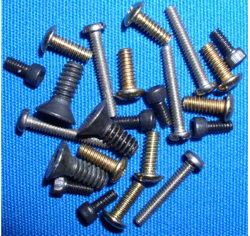Machine Vision Systems
Wood Product Inspection SystemsPrinting and Finish Inspection Systems
Metal Part Inspection Systems
Thread Analysis & Inspection Systems
Bearing Assembly Inspection Systems
Bearing Race Inspection Systems
Automotive Control Arm Inspection Systems
Manifold & Crossover Inspection Systems
Assembly Inspection Systems
Battery Inspection Systems
Tablet, Capsule and Pill Inspection Systems
Circuit Board Component Assembly Inspection Systems
Packaged Liquid Product Inspection Systems
Caps & Closures Inspection Systems
Gravity Belt Thickener Control
Ultra-Accurate Automatic Gauging Systems
The FyrEye-3210 thread analysis & inspection systems provide the customer 100% inspection of threaded components.
The FyrEye-3210 family systems provide automatic inspection for threaded products such as fasteners. FSI can provide accurate inspection of:
- Major diameter
- Minor diameter
- Pitch
- Thread angle
- Number of threads
- Completeness of threads
- Thread length
- Chips, cracks, and gouges
- Edge irregularities
- Surface analysis
- Warping

FyrEye 3210 family systems are capable of inspecting:
- Threaded rods
- Bolts
- Screws
- Nuts
- Metric threads
- SAE threads
- Reverse threads
- Fine threads
- Course threads
- Rolled threads
- Cut threads
- Molded threads
- Square threads
The FyrEye-3210 is a family of systems, customized to your application and requirements. Your particular model will be from the same family, but will have different variations in equipment and capabilities. The FyrEye-3210-02 is an example, it includes:
- Direct hardware trigger option.
- Fulfills application and performance specification # VAS-3210-02 (copy available). Each application will have its own VAS (Vision Application Spec Sheet).
- Engineered lighting specialized for solution performance and color rendition.
- Inspection of fasteners while flying (airborne, with planar tumbling) at a rate of 6 per second for full-circumference defects.
- Conditional storage of up to 140,000 images of rejected components for traceability, adaptability and QA program requirements.
Please contact FSI for a system and solution that is confirmed for your application.
FSI has been a trusted factory automation manufacturer for over 50 years. Our Assured Path to Success™ methods and programs have a 100% success rate in this field
of machine vision. Because our engineers are deeply involved in understanding the application, recommending the products, and supporting the software, these
systems are uniquely suited for long term supportability and standardization.
For printable version
click here






